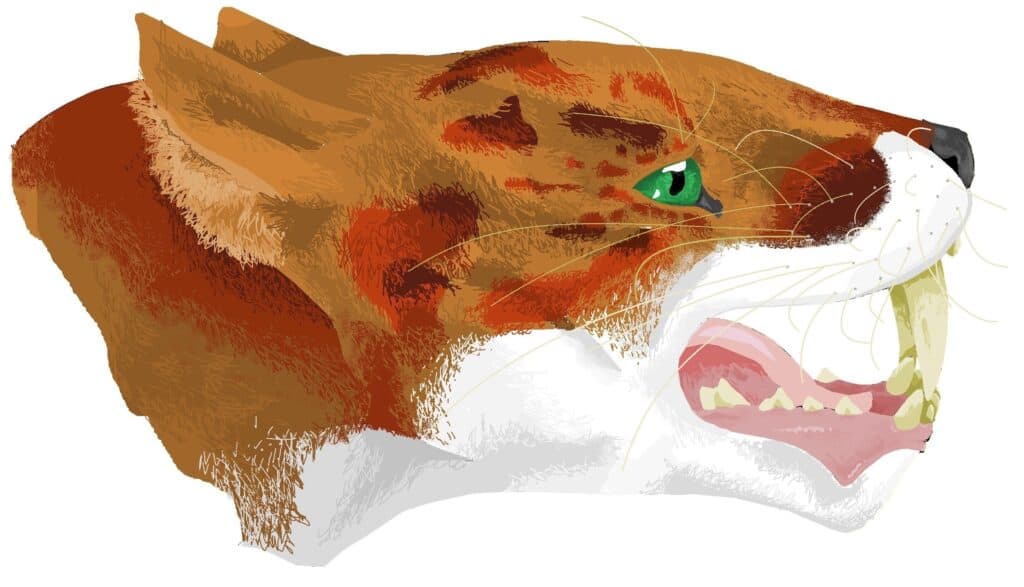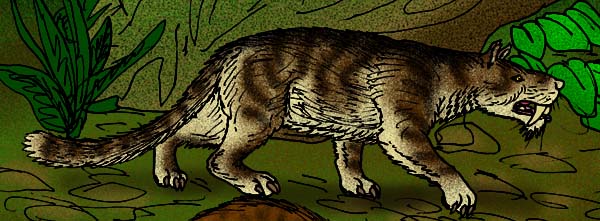If something is saber-toothed, we imagine that it’s a big cat. The idea of ancient humans fighting off Saber-Toothed Tigers is so exciting that it dominates the popular imagination.
There were numerous other saber-toothed animals that walked our earth millions of years ago, though. Some of them have even persisted to this day.
Don’t believe us? Just look at the Musk Deer, with its impeccable ability to make steal your heart then burrow into your nightmares like a haunted doll. That’s not the focus of this article, though.
Today, we’re talking about Machaeroides, the ancient dog-sized hunter whose name literally means “dagger-like.” While these animals weren’t as big as the Saber-Toothed Tiger, they could certainly pack a punch.
Let’s learn more about this small predator and how it stalked the pre-historic fauna of North America.

©By Coluberssymbol – Own work, CC BY-SA 3.0, https://commons.wikimedia.org/w/index.php?curid=15674306 – License
What Were Machaeroides?
These fierce creatures weren’t even related to big cats. They fell into an extinct order of animals known as the “Oxyaenidae,” which literally means “sharp hyenas.”
While they weren’t related, members of the order Oxyaenidae would have bore a passing resemblance to cats in appearance alone. In the case of Machaeroides, there’s a general consensus on the appearance of the animal. In almost all recreations, Machaeroides looks like a perfect combination of a dog, a cat, and a large rodent.
That’s not the scientific description, of course, but If you saw Machaeroides sniffing around your backyard on some fateful afternoon, you’d think “is that a dog? No, a cat? No, a huge badger? No..”
If this happens to you, it means you’ve time-warped back into the Eocene Epoch.
This Eocene Epoch, meaning “dawn,” marks the emergence of many of the modern orders of mammals. This Epoch lasted from around 56 million years ago to 40 million years ago, ending with a large extinction event that affected mostly water-dwelling animals.
Significant branches of faunal life emerged in a period called the Uintan North American Stage, which occurred roughly 46 million years ago and lasted 4.2 million years. We see all manner of large herbivores emerge, meaning that Machaeroides had plenty of prey to stalk along the plains.
Extremely Dangerous Predator
The purpose of Machaeroides’ saber teeth was to penetrate flesh and sink deep into the bodies of prey. The deeper the teeth go, the more likely the other animal is to die.
In the case of our cute & terrifying herbivorous Musk Deer, the teeth are only used in mating rituals. In contrast, Machaeroides would have been a truly difficult animal to live around. These creatures fed on almost any type of meat they could find.
They were specialized carnivores, targeting eggs, insects, and large mammals. As we mentioned, swarthes of large herbivorous mammals had just emerged and Machaeroides would have taken advantage of that fact.
Creodonts of all kinds were roaming North America, Eurasia, and Africa, occupying the top carnivorous positions in many ecosystems. Packs of Machaeroides would have been difficult to contend with, but close cousins in the Sarkastodon genus were some of the largest carnivorous mammals over to roam the earth.
They were hyper carnivores, eating the predecessors of rhinoceroses on a regular basis. So, while Machaeroides wasn’t among the largest mammalian predators of all time, they were closely related to some of the individuals who were. Think of the relationship between bobcats and lions; you know the bobcat isn’t capable of taking down a water buffalo like its lion cousins, but both animals share the set of feline qualities that demand respect.
The same goes for Machaeroides and Sarkastadons, respectively.
Imagining Machaeroides’ Behavior
We know that Machaeroides had a plantigrade walking pattern. This means they walked with most of their foot hitting the ground rather than walking on their toes like cats.
This is the earliest method that mammals had for walking. Walking on the toes or nails evolved later, while many animals (such as Homo sapiens and Machaeroides) retained this method. Plantigrade walkers are slower, but they have a stronger stance that’s advantageous for a number of reasons.
For one, pressing off of a firm stance and grabbing prey is a lot easier when you can lodge your whole foot into the ground. Being slower than your prey is disadvantageous, though, which is why Machaeroides probably hunted in packs.
Pack hunting, along with deadly teeth, allowed them to hunt animals that were a lot bigger than they were. Their prey would have included ungulates and other herbivores that were well-fed and populous at that time in the Eocene.

©By Apokryltaros at English Wikipedia, CC BY-SA 3.0, https://commons.wikimedia.org/w/index.php?curid=4757606 – License
Understanding The Subfamily Machaeroidinae
Machaeroides was the namesake for its larger subfamily, Machaeroidinae, which contained nine known subspecies. To give a little context as to where Machaeroides sits in the broader tree of life, let’s zoom out and examine where the Machaeroidinae subfamily exists.
At the base, we find that these animals are in the kingdom Animalia and the phylum Chordata. Dividing further, Machaeroides is in the class Mammalia and the grand order Ferungulata.
Ferungulata comprises almost all mammalian creatures, and literally means “wild beasts and ungulates.” This is where Machaeroides splits with the saber-toothed Tiger, as the former moves into the order Oxyaenodonta and the latter enters the order Carnivora.
Three Clades of Carnivores
At the time of the split, we see a clade emerge with three subcategories. This clade is called Pan-Carnivora and includes Carnivoramorpha (which encompasses all living Carnivora species), Hyaenodonta (literally, “hyena teeth”), and Oxyaenodonta (Machaeroides’ clade).
Individuals in the order Hyaenodonta would have been very similar to those in the order Oxyaenodonta, separated primarily by the nature of their teeth and the corresponding feeding behaviors. Oxyaenodonta teeth evolved for crushing and piercing, whereas Hyaenodonta teeth evolved for shearing.
Think of shearing teeth working similarly to scissors, whereas crushing teeth worked more like sharp hammers. It’s important to note that both Hyaenodonta and Oxyaenodonta are now extinct. Carnivora is the only one that remains.
The next step forward was the Oxyaenidae family, which was most common in North America during the late Paleocene, roughly 66 million years ago. This family split into four subfamilies, and Machaeroidinae was one of those.
One short step forward and we arrive at the genus Machaeroides, whose first-known fossils fell to the ground in Wyoming, United States some 50 million years ago. This group splits into M. eothen and M. simpsoni, although little is known about the distinction between these two.
The differences between M. eothen and simpsoni might not have been very big. We could even think of Canis lupus (modern wolves) as a similar species in this respect. For example, there are 38 known subspecies of C. lupus across the world, although many of which wouldn’t be distinguishable to the untrained eye.
Next Up…
Want to Learn More About Similar Animals? Read these and other articles.
- Saber-Toothed Tiger (Smilodon populator)
- Yes Dire Wolves Were Real. And They Were Terrifying
- Paleogene Period: Animals, When It Happened, and Major Events
- Discover the 10 Largest Cats in the World!
The photo featured at the top of this post is © By Alannis - Own work, CC BY-SA 3.0, https://commons.wikimedia.org/w/index.php?curid=14916175 – License / Original
FAQs (Frequently Asked Questions)
Was Machaeroides as big as a Saber-Toothed Tiger?
Although it possessed large saber teeth, Machaeroides was only the size of an average dog. Don’t let the size fool you, though, because these animals were well–built and study predators.
When and where did Machaeroides live?
These animals lived roughly 50 million years ago to around 40 million years ago. They were the most populous in North America, with the earliest fossil found in the state of Wyoming. They might have had smaller populations across Eurasia as well.
Why did Machaeroides die out?
The extinction of this species (and suborder) is attributed to both climate and competition. Climate change at the end of the Eocene Epoch may have made it impossible for individuals to survive. Further, competition with a family of carnivorans called “Nimravidae” might have edged Machaeroides out of the ecosystem.
These competing animals were closely related to big cats and would have occupied a similar position to Machaeroides in the food chain.
Thank you for reading! Have some feedback for us? Contact the AZ Animals editorial team.






